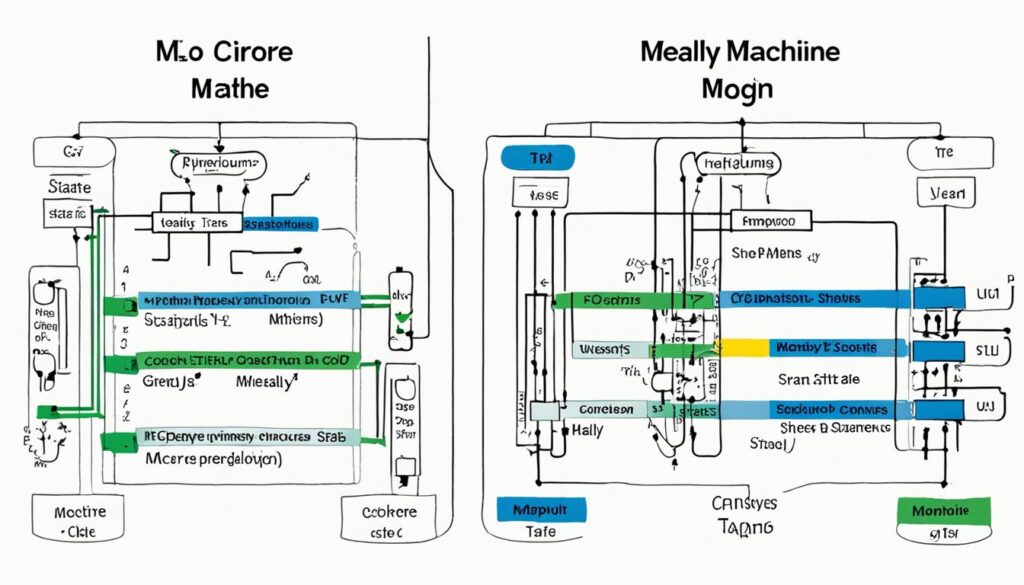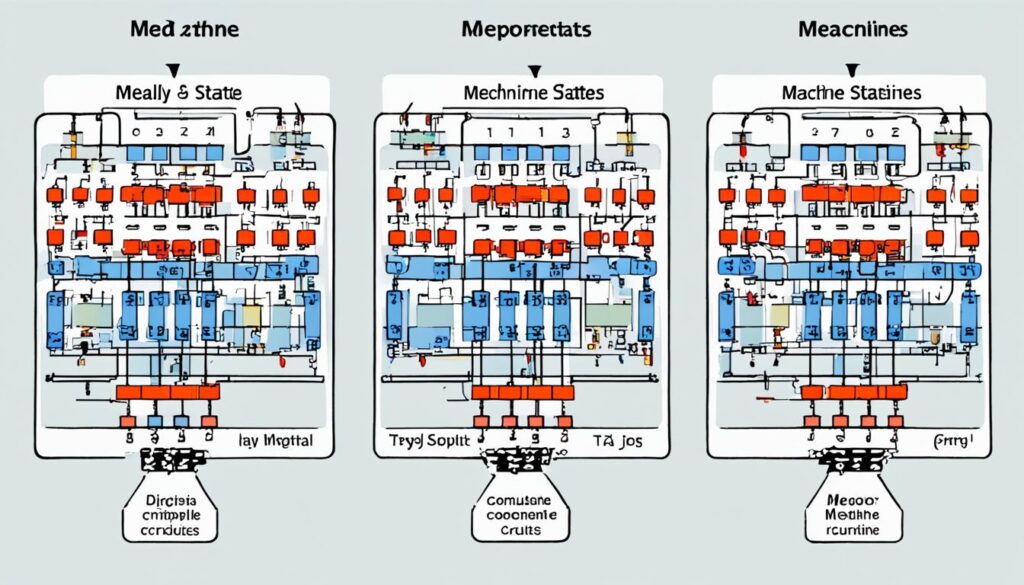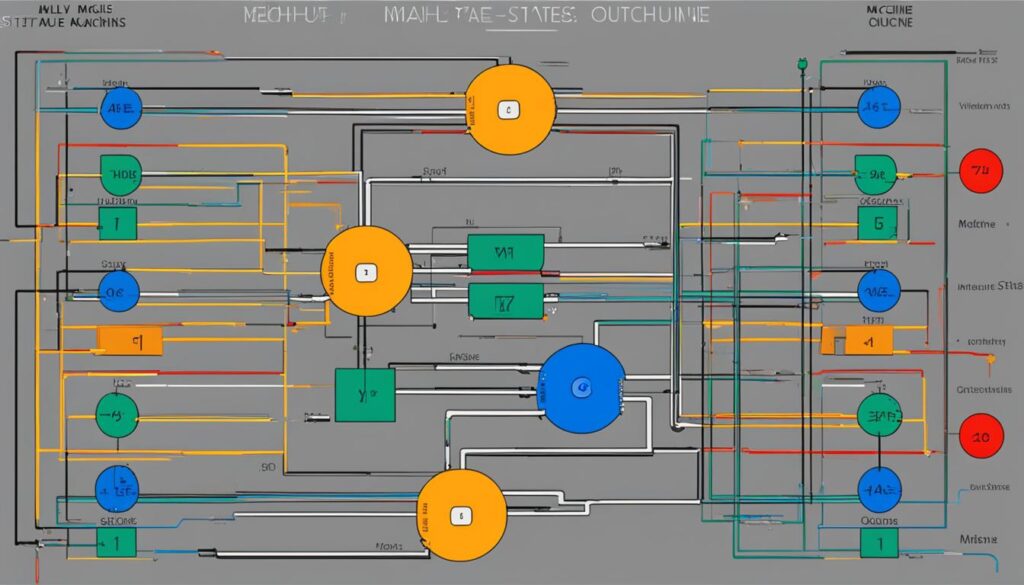State machines play a critical role in the design and implementation of digital circuits. Among the various types of state machines, Mealy and Moore state machines are widely used and offer distinct functionalities. Understanding the differences between these two concepts is essential for engineers and designers in the field of electronics.
In this article, we will explore the characteristics of Mealy and Moore state machines, their applications, and the considerations involved in their implementation. By examining their unique features, we can determine which type of state machine is best suited for specific design scenarios.
Let’s delve into the world of Mealy and Moore state machines and gain a comprehensive understanding of their significance in digital circuit design.
Table of Contents
Mealy State Machine: Definition and Characteristics
In the field of digital circuit design, understanding the concepts and characteristics of different state machines is crucial. One such state machine is the Mealy state machine, which plays a significant role in processing digital signals and determining outputs based on current inputs and states.
A Mealy state machine is a mathematical model that consists of a finite number of states and a set of transitions that dictate the behavior of the circuit. It processes a sequence of inputs and generates outputs based on the combination of the current input and the current state.
The Mealy state machine is primarily characterized by its output, which can change not only as a result of the current state but also due to the current input. This makes it highly flexible and efficient in various applications, as it can respond dynamically to different scenarios.
When a Mealy state machine receives an input, it evaluates the current state and input combination to determine the appropriate output. This output is dependent on the specific transition rules and logic implemented within the circuit. The Mealy state machine updates its current state based on the current input, thus allowing for iterative processing of subsequent inputs.
Implementing a Mealy state machine requires careful consideration of the current input, as it directly influences the output. This makes it essential to analyze and optimize the circuit design to ensure accurate and efficient operation.
Determining the Output: Current Input and Current State
The Mealy state machine leverages the current state and current input to determine the output. It evaluates the combination of the two factors to generate the desired output.
For example, let’s consider a digital circuit that controls the temperature in a greenhouse. The Mealy state machine in this scenario takes into account the current temperature and the desired temperature input to determine the appropriate output, such as turning on or off the heater or cooler. The output is computed based on the combination of the current temperature and the desired temperature, allowing for precise temperature control.
By utilizing the current input and state, the Mealy state machine enables efficient decision-making and output generation. This flexibility makes it suitable for a wide range of applications such as traffic signal control, data communication protocols, and automated systems.
Visual Representation of a Mealy State Machine
Above is an illustration of a Mealy state machine, showcasing its structure and transitions. Each oval represents a state, while the arrows indicate the transitions between states based on specific conditions. The labels on the arrows denote the input/output conditions associated with each transition, highlighting the dynamic nature of the Mealy state machine.
Moore State Machine: Definition and Features
In this section, we will explore the Moore state machine, understanding its definition and highlighting its distinctive features. A Moore state machine is a type of digital circuit that processes digital signals and generates outputs solely based on the current state, disregarding the current input. Let’s delve into its functioning and capabilities.
Features of a Moore State Machine
A Moore state machine has several notable features that set it apart from other types of digital circuits:
- Output based on current state: The output of a Moore state machine is solely dependent on the current state it is in. Unlike a Mealy state machine that also considers the current input, a Moore state machine derives its output directly from the current state without any external influence.
- Deterministic behavior: The behavior of a Moore state machine is deterministic, meaning that the transition from one state to another is solely determined by the current state. Once a transition occurs, the output remains constant until the next state transition.
- Reduced complexity: Moore state machines are known for their simplicity in comparison to other types of state machines. Since the output is solely determined by the state, there is no need to consider the current input, resulting in a reduced number of state transitions and simplified circuit design.
Now that we understand the fundamental features of a Moore state machine, let’s take a closer look at how it processes digital signals and generates outputs based on the current state.
| Current State | Output |
|---|---|
| State A | Output X |
| State B | Output Y |
| State C | Output Z |
Comparing and Contrasting Mealy and Moore State Machines
In this section, we will closely examine Mealy and Moore state machines, highlighting their key differences and similarities in terms of functionality and applications. By understanding these distinctions, designers and engineers can make informed decisions when selecting the most suitable state machine for specific digital circuit design scenarios.
Differences between Mealy and Moore State Machines
Mealy state machines and Moore state machines differ primarily in their output generation methods. In a Mealy state machine, the output is determined by both the current input and the current state, while in a Moore state machine, the output is solely dependent on the current state. This distinction enables Mealy state machines to have more flexibility in output generation, as it can consider the input in the output decision-making process.
Furthermore, Mealy state machines typically have fewer states compared to Moore state machines, resulting in simpler designs and faster execution. However, this reduced number of states may also introduce more complexity in the output generation logic due to the involvement of input signals.
Similarities between Mealy and Moore State Machines
Despite their differences, both Mealy and Moore state machines share several common characteristics. Firstly, they both represent dynamic systems that transition between different states based on specific input signals. Additionally, both types of state machines are widely used in digital circuit design to model and control complex systems.
Furthermore, both Mealy and Moore state machines can be implemented using a variety of digital components, such as flip-flops, logic gates, and registers. This versatility allows designers to select the most appropriate implementation approach based on the specific design requirements and constraints.
Advantages and Disadvantages of Mealy and Moore State Machines
When it comes to advantages, Mealy state machines offer greater flexibility in output generation by considering both the current input and state. This flexibility allows for more responsive and adaptable behavior, making Mealy state machines suitable for applications where real-time responses are critical.
On the other hand, Moore state machines are often preferred in scenarios where output stability and simplicity are key factors. By relying solely on the current state, Moore state machines exhibit more predictable behavior, which can simplify design and testing processes.
However, with their simplicity, Moore state machines may require a larger number of states to achieve the desired functionality compared to Mealy state machines. This increased state complexity can impact design feasibility and potentially limit their applications in certain scenarios.
Overall, the choice between Mealy and Moore state machines depends on the specific requirements and constraints of the digital circuit design. Designers must carefully consider factors such as real-time responsiveness, output stability, system complexity, and implementation considerations to select the most suitable state machine.
| Mealy State Machine | Moore State Machine |
|---|---|
| Output determined by current input and state | Output solely dependent on current state |
| Flexibility in output generation | More stable output behavior |
| Fewer states, faster execution | Potentially more states |
| Ideal for real-time responsiveness | Ideal for output stability |
By understanding the differences, similarities, and advantages/disadvantages of Mealy and Moore state machines, designers can effectively leverage these concepts to create efficient and reliable digital circuits.

Applications and Implementation Considerations
In this section, we will explore the practical applications of Mealy and Moore state machines in various real-world scenarios. These state machines play a crucial role in digital communication, control systems, and embedded systems, enabling the efficient processing and control of data. Let’s delve into the details of these applications and the important considerations to keep in mind when implementing Mealy and Moore state machines in digital circuits.
Applications of Mealy and Moore State Machines
Mealy and Moore state machines find extensive use in digital communication systems where the accurate and timely processing of data is vital. They are employed in protocols such as Universal Serial Bus (USB), Ethernet, and Serial Peripheral Interface (SPI) to ensure proper data transmission, synchronization, and error detection. These state machines enable efficient protocol implementation, ensuring reliable and seamless communication between devices.
In control systems, Mealy and Moore state machines are utilized to model and control complex processes. These state machines assist in tasks such as motor control, robotic navigation, and industrial automation. By encoding the system’s behavior into a state machine, engineers can effectively design control algorithms and ensure precision and stability in their applications.
Embedded systems heavily rely on Mealy and Moore state machines for efficient operation and resource management. These state machines are utilized in tasks such as device boot-up, power management, and user interface control. By incorporating state machines into the system design, developers can optimize the resource allocation, minimize power consumption, and enhance the overall performance of the embedded system.
Implementation Considerations
When implementing Mealy and Moore state machines in digital circuits, engineers need to consider various factors to ensure their effectiveness and reliability. Here are some important considerations:
- State Encoding: Choosing an appropriate state encoding scheme is vital to optimize the circuit’s performance and memory utilization. Different encoding methods, such as one-hot encoding or binary encoding, have different trade-offs in terms of circuit complexity, speed, and resource usage.
- Input/Output Handling: Defining the inputs and outputs accurately is crucial to ensure the state machine’s functionality aligns with the desired application requirements. Carefully selecting the input and output signals and determining their timing characteristics is essential for seamless integration and data processing.
- State Transition Logic: Designing the state transition logic correctly is essential to ensure proper sequencing and control flow within the state machine. Understanding the system’s behavior and the desired functionality is crucial for defining the state transition conditions accurately.
- Timing Considerations: Timing constraints play a crucial role in state machines’ implementations. Ensuring that the circuit meets the required timing specifications, such as clock cycles, setup and hold times, and maximum operating frequency, is vital for reliable and predictable operation.

Conclusion
In conclusion, this article has provided a comprehensive understanding of Mealy and Moore state machines in the context of digital circuit design. We have explored the differences between these two types of state machines, as well as their unique functions and applications.
By considering the characteristics, comparisons, and implementation considerations discussed, engineers and designers can make informed decisions when leveraging Mealy and Moore state machines in their projects.
Understanding the distinctions between Mealy and Moore state machines is crucial for designing efficient and reliable digital circuits. The choice between these two types of state machines depends on the specific requirements of the project and the desired behavior of the circuit.
Ultimately, by applying the knowledge gained from this article, engineers can optimize their digital circuit designs and ensure the successful implementation of Mealy and Moore state machines in a wide range of applications.

